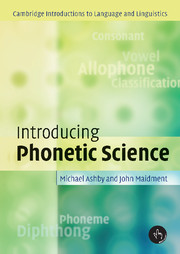10 - Suprasegmentals
Published online by Cambridge University Press: 05 June 2012
Summary
CHAPTER OUTLINE
In this chapter you will learn about: the use of fundamental frequency; the difference between lexical stress and rhythmic stress; lexical stress types, including fixed stress and variable stress; lexical tone languages, including contour tone and register tone languages; intonation and its role in determining the interpretation of utterances; paralinguistic features and their use in signalling speaker attitude.
KEY TERMS
Accent
Contour tone
Fixed stress
Fundamental frequency
Intonation
Key
Lexical tone
Nuclear tone
Nucleus
Paralinguistic features
Pitch
Register tone
Rhythm
Stress, primary and secondary
Variable stress
Introduction
We have looked in some detail at how speech sounds are produced, how they may influence each other and how they are organised into syllables. However, speech is not just a string of speech sounds. There are features of speech that span a number of speech sounds or a number of syllables or even whole utterances. Such features are called suprasegmental or prosodic features. They include lexical and rhythmic stress, lexical tone and intonation. In this chapter we will deal with variation in fundamental frequency and pitch and see how pitch variation is used in language to signal the difference between the meanings of words in lexical tone languages and how pitch is connected with lexical stress. Pitch variation is also very important at the level of the utterance. Intonation is used to signal how a speaker intends his or her utterances to be interpreted.
Fundamental frequency and pitch
We saw in Chapter 2 that the vocal folds can vibrate at different rates.
- Type
- Chapter
- Information
- Introducing Phonetic Science , pp. 153 - 176Publisher: Cambridge University PressPrint publication year: 2005



